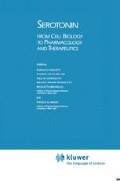Abstract
Subtypes of brain serotonin (5-HT) receptors mediate distinct electrophysiological effects via different effector mechanisms: 1) 5-HT1 receptors induce a slow hyperpolarization via pertussis toxin-sensitive G proteins coupled to the opening of K+ channels; 2) 5-HT2 receptors induce a slow depolarization, partly by a closing of K+ channels negatively modulated by a stimulation of phosphoinositide (PI) hydrolysis; 3) 5-HT3 receptors induce a response distinct from the others, a fast, rapidly desensitizing excitation.
Access this chapter
Tax calculation will be finalised at checkout
Purchases are for personal use only
Preview
Unable to display preview. Download preview PDF.
References
Aghajanian, G.K. (1980) ‘Mescaline and LSD facilitate the activation of locus coeruleus neurons by peripheral stimuli’, Brain Res. 186, 492–498.
Aghajanian, G.K., and Lakoski, J.M. (1984) ‘Hyperpolarization of serotonergic neurons by serotonin and LSD: studies in brain slices showing increased K+ conductance’, Brain Res. 305, 181–185.
Aghajanian, G.K., and Lakoski, J.M. (1984) ‘Hyperpolarization of serotonergic neurons by serotonin and LSD: studies in brain slices showing increased K+ conductance’, Brain Res. 305, 181–185.
Aghajanian, G.K., and VanderMaelen, C.P. (1986) ‘Specific systems of the reticular core: serotonin’, in V.B. Mountcastle, F.E. Bloom, and S.R. Geiger (eds.), Handbook of Physiology - The Nervous System IV, American Physiological Society, Bethesda, Maryland, pp. 237–256.
Andrade, R., Malenka, R.C., and Nicoll, R.A. (1986) ‘A G protein couples serotonin and GABAb receptors to the same channels in hippocampus’, Science 234, 1261–1265.
Andrade, R., and Nicoll, R.A. (1987) ‘Pharmacologically distinct actions of serotonin on single pyramidal neurones of the rat hippocampus recorded in vitro’. J.Physiol.(Lond) 394, 99–124.
Bradley, P.B., Engel, G., Feniuk, W., Fozard, J.R., Humphrey, P.P.A., Middlemiss, D.N., Mylecharane, E.J., Richardson, B.P., and Saxena, P.R. (1986) ‘Proposals for the classification and nomenclature of functional receptors for 5- hydroxytryptamine’, Neuropharmacology 25, 563 - 576.
Colino, A., and Halliwell, J.V. (1987) ‘Differential modulation of three separate K-conductances in hippocampal CA1 neurons by serotonin’, Nature 327, 73–77.
Conn, P.J., and Sanders-Bush, E. (1986) ‘Regulation of serotonin-stimulated phosphoinositide hydrolysis: relation to the serotonin 5-HT2 binding site’, J.Neurosci. 6, 3669–3675.
Davies, M.F., Deisz, R.A., Prince, D.A., and Peroutka, S.J. (1987) ‘Two distinct effects of 5-hydroxytryptamine on single cortical neurons’, Brain Res. 423, 347–352.
deMontigny, C., Blier, P., and Chaput, Y. (1984) ‘Electrophysiologically- identified serotonin receptors in the rat CNS’, Neuropharmacology 23, 1511–1520.
Glennon, R.A., Titeler, M., and McKenney, J.D. (1984) ‘Evidence for 5-HT2 involvement in the mechanism of action of hallucinogenic agents’, Life Sci. 35, 2505–2511.
Innis, R.B., Nestler, E.J., and Aghajanian, G.K. (1988) ‘Evidence for G protein mediation of serotonin- and GABAb -induced hyperpolarization of rat dorsal raphe neurons’, Brain Res. 459, 27–36.
Joels, M., Shinnick-Gallagher, P., and Gallagher, J.P. (1987) ‘Effect of serotonin and serotonin analogues on passive membrane properties of lateral septal neurons in vitro’. Brain Res. 417, 99–107.
Kilpatrick, G.J., Jones, B.J., and Tyers, M.B. (1987) ‘Identification and distribution of 5-HT3 receptors in rat brain using radioligand binding’, Nature 330, 746–748.
McCall, R.B., and Aghajanian, G.K. (1979) ‘Serotonergic facilitation of facial motoneuron excitation’, Brain Res. 169, 11–27.
McCall, R.B., and Aghajanian, G.K. (1980a) ‘Pharmacological characterization of serotonin receptors in the facial motor nucleus: a microiontophoretic study’, Eur.J.Pharmacol. 65, 175–183.
McCall, R.B., and Aghajanian, G.K. (1980b) ‘Hallucinogens potentiate responses to serotonin and norepinephrine in the facial motor nucleus’, Life Sci. 26, 1149–1156.
Nedergaard, S., Engberg, I., and Flatman, J.A. (1987) ‘The modulation of excitatory amino acid responses by serotonin in the cat neocortex in vitro’, Cell.Molec.Neurobiol. 7, 367–379.
Pazos, A., and Palacios, J.M. (1985a) ‘Quantitative autoradiographic mapping of serotonin receptors in the rat brain. L Serotonini receptors’, Brain Res. 346, 205–230.
Pazos, A., Cortes, R., and Palacios, J.M. (1985b) ‘Quantitative autoradiographic mapping of serotonin receptors in the rat brain. II. Serotonin2 receptors’, Brain Res. 346, 231–249.
Peroutka, S.J. (1988) ‘5-hydroxytryptamine receptor subtypes: molecular, biochemical and physiological characterization’, TINS 11, 496–500.
Peroutka, S.J., and Snyder, S.H. (1979) ‘Multiple serotonin receptors: differential binding of [3H]5 -hydroxytryptamine, [3H]lysergic acid diethylamide and [3H]spiroperidol’, Molec.Pharmacol. 16, 687–699.
Rasmussen, K., and Aghajanian, G.K. (1986) ‘Effects of hallucinogens on spontaneous and sensory-evoked locus coeruleus unit activity in the rat: reversal by selective 5-HT2 antagonists’, Brain Res. 385, 395–400.
Rasmussen, K., and Aghajanian, G.K. (1988) ‘Serotonin excitation of facial motoneurons: mediation through a 5-HT2 receptor’, Soc.Neurosci.Abst. 14, 610.
Sanders-Bush, E. Burris, K.D., and Knoth, K.. (1988) ‘Lysergic acid diethylamide and 2,5-dimethoxy-5-methylamphetamine are partial agonists at serotonin receptors linked to phosphoinositide hydrolysis’, J.Pharmacol.Exp.Ther. 246, 924–928.
Sheldon, P.W., and Aghajanian, G.K. (1988) ‘Serotonin (5-HT) and norepinephrine (NE) induce IPSPs in pyramidal cells of the piriform cortex: evidence for a 5-HT2 and ai activated interneuron’, Soc.Neurosci.Abst. 14, 215.
Sprouse, J.S., and Aghajanian, G.K. (1987) ‘Electrophysiological responses of serotonergic dorsal raphe neurons to 5-HT1A and 5-HT1B agonists’, Synapse 1, 3–9.
Sprouse, J.S., and Aghajanian, G.K. (1988) ‘Responses of hippocampal pyramidal cells to putative serotonin 5-HT1 a and 5-HT1 b agonists: a comparative study with dorsal raphe neurons’, Neuropharmacology 27, 707–715.
VanderMaelen, C.P., and Aghajanian, G.K. (1980) ‘Intracellular studies showing modulation of facial motoneurone excitability by serotonin’, Nature 287, 346–347.
Verge, D., Daval, G., Patey, A., Gozlan, H., El Mestikawy, S., and Hamon, M. (1985) ‘Presynaptic 5-HT autoreceptors on serotonergic cell bodies and/or dendrites but not terminals are of the 5-HT1A subtype’, Eur.J.Pharmacol. 113, 463–464.
Williams, J.T., Colmers, W.F., and Pan, Z.Z. (1988) ‘Voltage- and ligand-activated inwardly rectifying currents in dorsal raphe neurons in vitro’, J.Neurosci. 8, 3499–3506.
Yakel, J.L., and Jackson, M.B. (1988) ‘5-HT3 receptors mediate rapid responses in cultured hippocampus and a clonal cell line’, Neuron 1, 615–621.
Author information
Authors and Affiliations
Editor information
Editors and Affiliations
Rights and permissions
Copyright information
© 1990 Kluwer Academic Publishers
About this chapter
Cite this chapter
Aghajanian, G.K., Sprouse, J.S., Sheldon, P., Rasmussen, K. (1990). Electrophysiology of Brain Serotonin Receptors: Subtype Specificity for Effector Mechanisms. In: Paoletti, R., Vanhoutte, P.M., Brunello, N., Maggi, F.M. (eds) Serotonin. Springer, Dordrecht. https://doi.org/10.1007/978-94-009-1912-9_35
Download citation
DOI: https://doi.org/10.1007/978-94-009-1912-9_35
Publisher Name: Springer, Dordrecht
Print ISBN: 978-94-010-7353-0
Online ISBN: 978-94-009-1912-9
eBook Packages: Springer Book Archive

